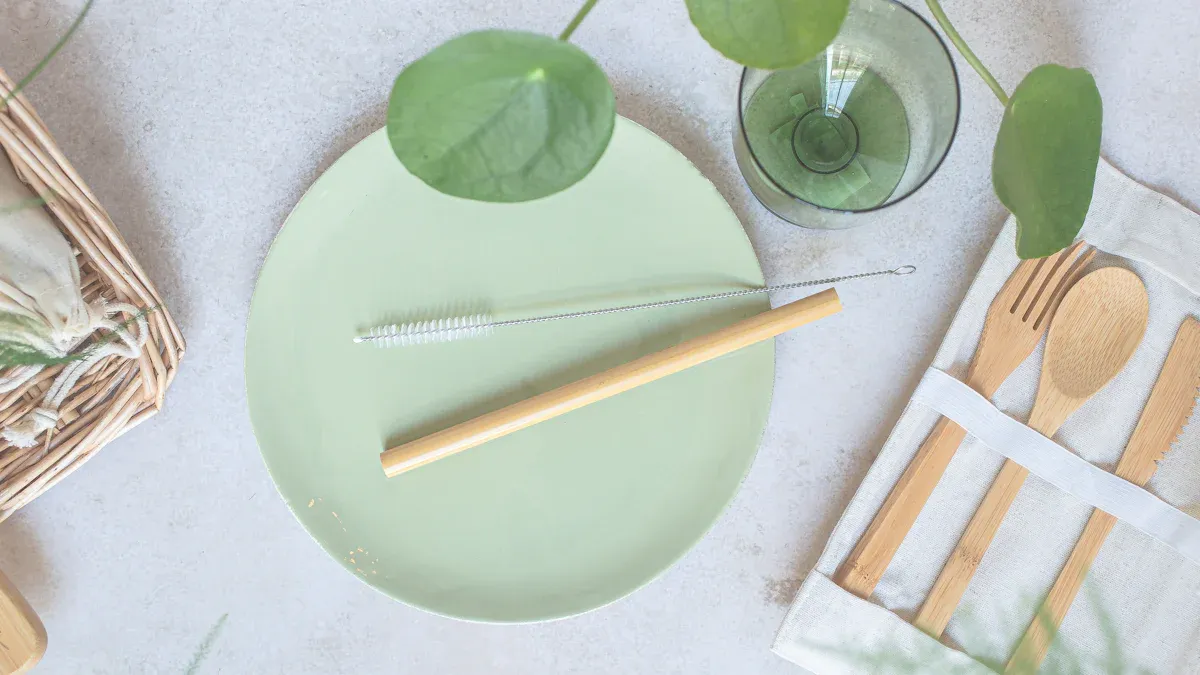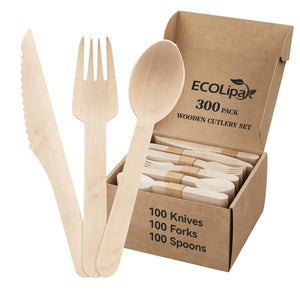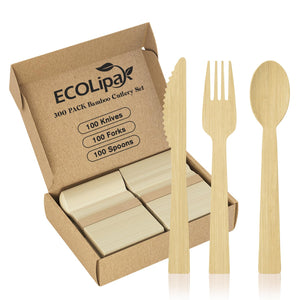If you want to make a better choice for the environment, wood cutlery stands out over plastic. You help protect nature when you pick wood cutlery because:
It is biodegradable, so it breaks down naturally.
Wood comes from renewable resources.
Plastic cutlery does not break down and adds to pollution.
You can find eco-friendly wood cutlery from brands like Ecolipak, which lets you enjoy meals while caring for the planet.
Key Takeaways
Choose wood cutlery to help the environment. It is biodegradable and breaks down naturally, reducing pollution.
Plastic cutlery takes hundreds to thousands of years to decompose, contributing to long-term environmental harm.
Using compostable wood cutlery supports healthy soil and reduces waste. It can break down in just 90 to 180 days.
Wood cutlery comes from renewable resources, making it a sustainable choice compared to non-renewable plastic.
Switching to eco-friendly options like Ecolipak's wooden cutlery helps protect wildlife and keeps communities cleaner.
Wood Cutlery vs. Plastic Cutlery

Environmental Impact
When you choose what kind of cutlery to use, you make a real difference for the environment. Wood cutlery and plastic cutlery have very different effects on the planet. You can see the main differences in how they break down and what happens after you throw them away.
Here is a simple table to help you compare:
Type of Cutlery |
Biodegradability |
Notes |
|---|---|---|
Wood Cutlery |
Biodegradable |
Decomposes in natural environments |
Plastic Cutlery |
Not effectively biodegradable |
Many products falsely claim biodegradability |
Plastic cutlery relies on materials that come from oil. These materials do not break down easily. When you throw away plastic cutlery, it can stay in the environment for hundreds or even thousands of years. This leads to pollution and harms animals and people. Plastic cutlery often ends up in landfills or the ocean, where it turns into tiny pieces called microplastics.
Wooden cutlery, like the single-use wood cutlery from Ecolipak, comes from renewable resources. It breaks down naturally in compost or soil. If you compost wooden cutlery, it can disappear in just a few months. This helps keep the earth clean and safe for everyone.
Tip: When you pick wooden cutlery, you help reduce pollution and protect nature for future generations.
Key Differences
You might wonder what makes wood cutlery and plastic cutlery so different. Here are the key points you should know:
Plastic cutlery uses unsustainable materials and creates a lot of waste.
Most plastic cutlery is not recycled. It often ends up in landfills or as litter.
Plastic cutlery can take about a thousand years to break down. It causes long-term harm to the environment.
Wood cutlery, especially when sourced responsibly, is biodegradable and compostable.
Composting wooden cutlery reduces methane emissions, which helps fight climate change.
Wooden cutlery from Ecolipak can break down in 90 to 180 days under the right composting conditions.
Plastic cutlery stays in the environment for hundreds of years and adds to microplastic pollution.
When you use single-use wood cutlery, you choose a product that supports a cleaner planet. Ecolipak offers eco-friendly options that help you make a positive impact every day.
Biodegradability of Wooden Cutlery
Natural Decomposition
You make a smart choice for the planet when you use wood cutlery. This type of cutlery is compostable and breaks down naturally, even if you do not have access to special composting facilities. Most wooden cutlery comes from fast-growing trees in managed forests, often certified by the Forest Stewardship Council (FSC). Experts agree that these utensils are better for the environment because they decompose and enrich the soil.
Wood cutlery can break down in about 90 days when you dispose of it properly. As it decomposes, it returns nutrients to the earth. You help reduce waste and support healthy soil when you choose single-use wood cutlery for your meals. The process is simple and does not require much effort from you.
Here is a table showing how different factors affect the decomposition of wooden cutlery:
Factor |
Description |
|---|---|
Composting Environment |
Wooden cutlery decomposes quickly in a well-managed compost pile. |
Material and Treatment |
Untreated wood decomposes faster than treated or varnished wood. |
Thickness and Size |
Thinner utensils break down faster than thicker ones. |
Temperature and Climate |
High temperatures in composting facilities can decompose cutlery in weeks. |
Temperature, moisture, and oxygen all play a role in how fast wood cutlery breaks down. Warm, moist, and oxygen-rich environments help microbes work faster. Rich soil also speeds up the process.
Plastic Cutlery in Landfills
Plastic cutlery creates a very different story. Nearly 100 million plastic utensils end up in landfills every day in the United States. These utensils do not break down naturally. Plastic cutlery can take between 200 and 1,000 years to decompose, which means it stays in the environment for generations.
Plastic cutlery fragments into microplastics, which can carry harmful substances like heavy metals and toxins. These microplastics contaminate soil and water, posing risks to wildlife and people. The decomposition process in landfills also releases greenhouse gases such as CO2 and methane, adding to climate change.
Choosing compostable wood cutlery helps you protect your family’s health and the environment. You reduce pollution and keep harmful plastics out of nature.
Pollution and Waste
Production Pollution
You make a big impact on the planet when you choose your cutlery. The way manufacturers produce wooden and plastic cutlery creates very different levels of pollution. Wooden cutlery uses renewable resources and breaks down quickly, while plastic cutlery relies on fossil fuels and stays in landfills for centuries.
Here is a table showing how each type affects pollution:
Type of Cutlery |
Pollution Level Description |
|---|---|
Wooden Cutlery |
Biodegradable and compostable, decomposes within months, reducing landfill impact. |
Plastic Cutlery |
Non-biodegradable, can take up to 500 years to degrade, significantly contributes to landfill pollution. |
Plastic cutlery production releases harmful air pollutants. These pollutants often affect low-income and marginalized communities. Open burning of plastic waste adds toxic gases and microplastics to the air. You help reduce this pollution when you choose wooden cutlery. Wood cutlery does not release toxins during production or disposal. It breaks down naturally and does not harm the environment.
Litter and Microplastics
Plastic cutlery creates a huge waste problem. Over 359 million tonnes of plastic are produced every year, with more than 40% used for single-use items like cutlery. An estimated 8 million tonnes of mismanaged plastic waste enter the oceans each year. Rivers carry millions of tonnes of plastic waste into the ocean, where it breaks down into microplastics.
Microplastics pollute water supplies and harm wildlife. These tiny pieces can even enter your food and water, posing risks to your health. Preventing plastics from entering waterways is crucial for protecting nature and your family. Improved waste management and recycling help, but choosing biodegradable options makes the biggest difference.
Wooden cutlery does not leach harmful chemicals. It decomposes naturally without leaving toxins behind. You protect local ecosystems and wildlife when you pick wood cutlery. Plastic cutlery, on the other hand, breaks down into microplastics and releases toxins, causing long-term damage.
🌱 Choosing wooden cutlery helps you keep your community cleaner and safer. You support a healthier planet for future generations.
Sustainability and Resource Use
Renewable Materials
You make a big difference when you choose products made from renewable materials. Wood cutlery comes from trees, which can be replanted and grown again. This makes it a sustainable choice for your family and the planet. Ecolipak uses responsibly sourced wood for its single-use wood cutlery. The company supports managed forests, which protect wildlife and keep forests healthy for future generations. When you pick wood cutlery, you support a cycle that gives back to nature.
Plastic cutlery, on the other hand, comes from petroleum. Petroleum is a non-renewable resource. Once it is used, it cannot be replaced. This makes plastic cutlery less sustainable and more harmful to the environment. Many communities now support a single-use plastic ban to help reduce this problem.
Here is a table that shows how wood and plastic cutlery compare in terms of sustainability:
Aspect |
Wooden Cutlery |
Plastic Cutlery |
|---|---|---|
Biodegradability |
Decomposes within months to years |
Takes centuries to break down |
Sourcing |
Derived from renewable resources |
Produced from non-renewable petroleum |
Chemical Use |
Involves fewer harmful chemicals |
Often involves harmful chemicals |
Energy Consumption |
Lower energy consumption in production |
Higher energy consumption in production |
Landfill Impact |
Contributes less to landfill waste |
Significant contribution to landfill waste |
Energy and Carbon Footprint
You help lower your carbon footprint when you choose sustainable products. Making wood cutlery uses energy and water, but it comes from renewable sources and breaks down naturally. Ecolipak works to keep its process eco-friendly by using efficient manufacturing and local sourcing when possible. Transporting wood cutlery does create some carbon emissions because wood is heavier than plastic, but the overall impact is still lower than plastic.
Plastic cutlery needs more energy to produce. The process uses oil and chemicals, which release more greenhouse gases. Even plant-based plastics, like CPLA, require chemical processing and energy, which adds to their carbon footprint. When you look at the whole lifecycle, wood cutlery stands out as the better choice for the environment.
By choosing single-use wood cutlery, you support a cleaner world and set a positive example for your community.
End-of-Life and Disposal
Composting Wooden Cutlery
You help the planet when you choose wood cutlery that is compostable. After you finish your meal, you can place these utensils in a compost bin. Over time, they break down and turn into healthy soil. This process supports gardens and green spaces in your community. Compostable utensils, like those from Ecolipak, often carry third-party certifications. These certifications show that the products decompose quickly and safely.
The speed of composting depends on several factors. The environment, the type of wood, and the thickness of the utensil all play a role. In a well-managed compost pile, wooden cutlery can break down in just a few months. You do not need special equipment. You simply add the utensils to your compost and let nature do the work.
🌱 Tip: Composting wooden cutlery helps you reduce waste and support a cleaner environment for your family.
Recycling and Landfill Issues
Plastic cutlery creates many problems at the end of its life. Most plastic utensils are made from materials that recycling centers do not accept. Their small size and shape make them hard to sort and process. Many facilities reject plastic cutlery, so it ends up in landfills. Only a tiny fraction of all plastic waste gets recycled—less than 9%. Plastic cutlery makes up an even smaller part of that number.
Here is a quick look at what happens to plastic cutlery after use:
Disposal Method |
What Happens Next |
|---|---|
Recycling |
Most plastic cutlery gets rejected and sent to landfill |
Landfill |
Stays for hundreds of years, adding to pollution |
Litter |
Breaks into microplastics, harming wildlife |
You can help by supporting the single-use plastic ban in your community. This action keeps harmful plastics out of landfills and waterways. When you choose compostable wood cutlery, you make a positive impact on the environment and your family's health.
Practical Benefits for the Environment
Durability and Waste Reduction
You want your tableware to be strong enough for any meal. Ecolipak’s compostable wooden cutlery gives you that strength. Customers say these utensils do not bend or break, even when you use them for steak or salad. You can trust them for picnics, parties, and family dinners. The smooth finish feels comfortable in your hand. You do not have to worry about splinters or rough edges.
When you use single-use wood cutlery, you help reduce waste. Unlike plastic, wood breaks down quickly in compost. You do not leave behind harmful microplastics. Families who switched to Ecolipak noticed less trash after events. They felt proud knowing their choices kept parks and playgrounds cleaner. You help protect green spaces for your children and neighbors.
Wood is a renewable resource.
The energy needed to make wood cutlery is much lower than for plastic.
Manufacturing wooden utensils creates less pollution.
You can compost wooden cutlery after use.
Choosing compostable utensils means you support a cleaner planet and healthier communities.
Cost and Accessibility
You may wonder if eco-friendly products cost more. Ecolipak’s wooden cutlery is priced to match traditional options. Customers say they get great value for their money. You do not pay extra for sustainability. The cutlery comes in large packs, making it easy for families and businesses to stock up. You can use these utensils for birthday parties, school lunches, or food trucks.
Reusable options are available, but for big events or busy days, single-use wood cutlery offers convenience without guilt. You do not need special disposal methods. Just add them to your compost bin. Ecolipak’s products are easy to order online and ship quickly across the country. You make a smart choice for your budget and the environment.
Families and businesses love the balance of quality, price, and eco-friendliness. You can enjoy every meal knowing you made a responsible decision.
Choosing the Best Option
Eco-Conscious Recommendations
You want to make choices that protect your family and the planet. When you compare wood cutlery to plastic, you see clear differences. Every year, people in the U.S. throw away about 40 billion plastic utensils. These items cannot be recycled easily because food waste contaminates them. Plastic utensils often contain chemicals like BPA and BPS. BPA can affect your health by disrupting hormones, while BPS harms aquatic life and damages ecosystems.
You can use the table below to help you decide which option fits your values:
Factor |
Wooden/Bamboo Cutlery |
Plastic Cutlery |
|---|---|---|
Biodegradability |
Yes |
No |
Harmful Chemicals |
Sometimes |
Yes |
Environmental Impact |
Emits methane in landfills |
Harms ecosystems |
If you want to reduce waste, you can choose compostable wooden cutlery for parties, picnics, or daily meals. For everyday use, you might consider reusable utensils at home. You help keep your community cleaner and safer when you avoid single-use plastics.
🌱 Tip: Small changes in your daily routine, like switching to wooden or reusable cutlery, can make a big difference for your family’s health and the environment.
Why Ecolipak Stands Out
You deserve products that match your commitment to sustainability. Ecolipak stands out because it uses high-quality, sustainably sourced hardwoods such as birch and maple. These materials make the cutlery sturdy and eco-friendly. You can compost Ecolipak’s wooden utensils after use, which helps reduce landfill waste and supports a circular economy.
Many families and businesses now look for eco-friendly products. Ecolipak meets this demand by offering compostable and biodegradable options. Customers praise the durability and comfort of Ecolipak’s cutlery. You get reliable performance for any meal, from salads to steaks. Ecolipak’s mission is to make green living easy and accessible for everyone.
You help protect green spaces and support a cleaner future when you choose Ecolipak for your events and daily needs.
You make a real difference when you choose wood cutlery over plastic. Wood cutlery breaks down naturally and helps protect the environment. You support a cleaner world for your family and community. For your next meal or event, pick compostable options like Ecolipak’s wooden cutlery. Small changes in your daily choices lead to a healthier planet for everyone.
FAQ
Can you compost Ecolipak wooden cutlery at home?
Yes, you can compost Ecolipak wooden cutlery in your backyard compost bin. The utensils break down naturally and enrich your soil. You help reduce waste and support a healthier garden.
Is wooden cutlery safe for hot foods?
Ecolipak wooden cutlery resists heat up to 302°F. You can use it for hot soups, stews, or coffee. The utensils stay sturdy and do not bend or release harmful chemicals.
How does wooden cutlery help protect wildlife?
Wooden cutlery breaks down quickly and does not create microplastics. You keep harmful plastics out of rivers and oceans. Animals stay safer when you choose biodegradable options.
Does Ecolipak wooden cutlery cost more than plastic?
You pay a similar price for Ecolipak wooden cutlery compared to plastic utensils. You get strong, eco-friendly products without spending extra. Families and businesses find it affordable and practical.
Why should you switch from plastic to wood cutlery?
You help protect your family’s health and the planet. Wood cutlery reduces pollution and landfill waste. You make a positive impact every time you choose compostable utensils.







